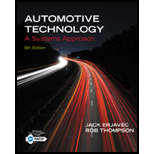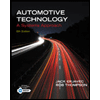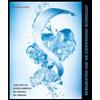
Automotive Technology: A Systems Approach (MindTap Course List)
6th Edition
ISBN: 9781133612315
Author: Jack Erjavec, Rob Thompson
Publisher: Cengage Learning
expand_more
expand_more
format_list_bulleted
Textbook Question
Chapter 34, Problem 8RQ
List five common causes for high HC emissions.
Expert Solution & Answer
Want to see the full answer?
Check out a sample textbook solution
Students have asked these similar questions
What is the current available emission standard in the Philippines? Explain.
Explain steps involved in disconnecting a fuel line on a vehicle with multiport fuel injaction and gasoline direct injection ?
Write down the methods of reducing NOx emissions in a combustion system.
Chapter 34 Solutions
Automotive Technology: A Systems Approach (MindTap Course List)
Ch. 34 - A rich air-fuel ratio causes HC emissions to...Ch. 34 - What will result from too little EGR flow? And...Ch. 34 - What can result from a charcoal canister that is...Ch. 34 - What happens if a PCV valve is stuck in the open...Ch. 34 - Explain why the I/M 240 and similar tests are...Ch. 34 - How do you test the efficiency of a secondary AIR...Ch. 34 - True or False? No-start, surging, or stalling can...Ch. 34 - List five common causes for high HC emissions.Ch. 34 - Describe carbon monoxide (CO) emissions in...Ch. 34 - A restricted catalytic converter can cause all of...
Ch. 34 - Which of the following statements about EVAP...Ch. 34 - As a catalytic converter begins to deteriorate,...Ch. 34 - How much pressure does a typical EVAP pressure...Ch. 34 - Which of the following exhaust gases is typically...Ch. 34 - Prob. 15RQCh. 34 - While discussing the proper way to test a...Ch. 34 - Prob. 2ASRQCh. 34 - While discussing catalytic converter diagnosis:...Ch. 34 - While discussing EGR valve diagnosis: Technician A...Ch. 34 - While discussing EGR valve diagnosis: Technician A...Ch. 34 - When discussing the diagnosis of a positive back...Ch. 34 - While diagnosing a PCV problem: Technician A says...Ch. 34 - Technician A says that the AIR system should pump...Ch. 34 - While discussing PCV system diagnosis: Technician...Ch. 34 - While discussing EVAP testing: Technician A says...
Knowledge Booster
Learn more about
Need a deep-dive on the concept behind this application? Look no further. Learn more about this topic, mechanical-engineering and related others by exploring similar questions and additional content below.Similar questions
- While discussing automotive emissions: Technician A says that oxygen emissions are monitored because they are an indication of the completeness of the combustion process. Technician B says that the conditions for minimizing HC emissions are the same as those that cause high NOx emissions. Who is correct? a. Technician A only b. Technician B only c. Both A and B d. Neither A nor Barrow_forwardWhy is the sulfur content in gasoline limited?arrow_forwardName the three types of emissions being controlled in gasoline engines.arrow_forward
arrow_back_ios
SEE MORE QUESTIONS
arrow_forward_ios
Recommended textbooks for you
 Automotive Technology: A Systems Approach (MindTa...Mechanical EngineeringISBN:9781133612315Author:Jack Erjavec, Rob ThompsonPublisher:Cengage Learning
Automotive Technology: A Systems Approach (MindTa...Mechanical EngineeringISBN:9781133612315Author:Jack Erjavec, Rob ThompsonPublisher:Cengage Learning Automotive TechnologyMechanical EngineeringISBN:9781337794213Author:ERJAVEC, Jack.Publisher:Cengage,
Automotive TechnologyMechanical EngineeringISBN:9781337794213Author:ERJAVEC, Jack.Publisher:Cengage, Refrigeration and Air Conditioning Technology (Mi...Mechanical EngineeringISBN:9781305578296Author:John Tomczyk, Eugene Silberstein, Bill Whitman, Bill JohnsonPublisher:Cengage Learning
Refrigeration and Air Conditioning Technology (Mi...Mechanical EngineeringISBN:9781305578296Author:John Tomczyk, Eugene Silberstein, Bill Whitman, Bill JohnsonPublisher:Cengage Learning

Automotive Technology: A Systems Approach (MindTa...
Mechanical Engineering
ISBN:9781133612315
Author:Jack Erjavec, Rob Thompson
Publisher:Cengage Learning

Automotive Technology
Mechanical Engineering
ISBN:9781337794213
Author:ERJAVEC, Jack.
Publisher:Cengage,

Refrigeration and Air Conditioning Technology (Mi...
Mechanical Engineering
ISBN:9781305578296
Author:John Tomczyk, Eugene Silberstein, Bill Whitman, Bill Johnson
Publisher:Cengage Learning
Extent of Reaction; Author: LearnChemE;https://www.youtube.com/watch?v=__stMf3OLP4;License: Standard Youtube License